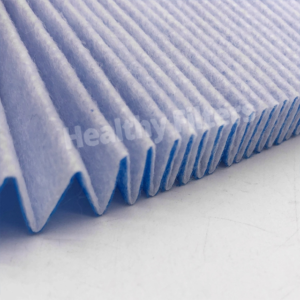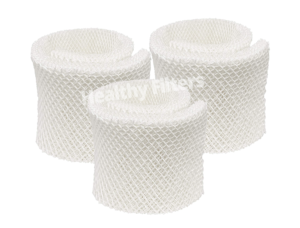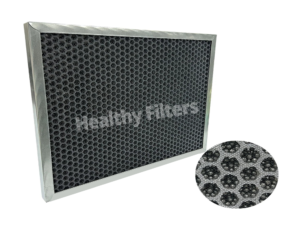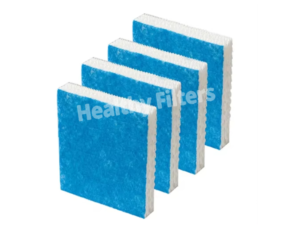Synthetic Fiber Pocket Filter F9 is a quasi-high-efficiency air filtration device that complies with EN 1822 and ISO 16890 ePM1 90%-95% standards. Its filtration performance is close to HEPA H13 level. It is designed to intercept 0.1-5μm ultrafine particles (such as viruses, bacteria, smoke, aerosols and nano-scale industrial dust). It uses cutting-edge composite fiber technology and reinforced structure, becoming the core purification component of ultra-sensitive scenarios such as biopharmaceuticals, semiconductor manufacturing, and high-grade clean rooms, providing top protection for process sterilization and personnel health.
Core structure and technical parameters
Material and process
Filter material:
Mixed fiber layer: glass fiber (diameter 0.6-1μm) and ultra-fine polyester electret fiber composite, gradient density design (coarse efficiency + medium efficiency + HEPA level), electrostatic electret technology enhances the electrostatic adsorption of 0.1μm particles;
Function enhancement: nano hydrophobic coating (contact angle>150°), antibacterial silver ion impregnation (antibacterial rate ≥99.9%).
Bag structure: 20-40 W-type or Z-type pleated filter bags, the effective filtration area is 8-12 times that of flat filter materials, the dust holding capacity is 1200-2000g/m², and the service life is leading in the industry.
Sealing frame: stainless steel or flame-retardant PPS (polyphenylene sulfide) frame, temperature resistance -50℃ to 120℃, EPDM sealing ring resistant to ozone and chemical corrosion.
Performance parameters
Filtration efficiency:
PM0.1 filtration efficiency ≥99% (corresponding to ISO ePM1 95%+), PM0.3 ≥99.97% (EN 1822 H13 standard);
Interception rate of 0.1μm particles ≥99.5% (MPPS method test).
Initial pressure difference: ≤130Pa (@rated air volume), energy consumption is reduced by 15%-25% compared with traditional F9 filter element.
Environmental tolerance: humidity ≤98% RH, acid and alkali resistance (pH 3-11), resistance to organic solvents (such as acetone, ethanol).
Core advantages
Advantage dimensions Specific performance User value
Ultimate purification The ability to intercept viruses and nanoparticles reaches HEPA H13 level Meet ISO Class 5 clean room and biosafety level 3 (BSL-3) requirements
Extreme life The industry’s top dust holding capacity, replacement cycle up to 18-36 months Operation and maintenance costs are reduced by 50%, suitable for 24/7 continuous production scenarios
Safety and compliance Passed FDA 21 CFR, EU GMP Annex 1 certification, no fiber shedding Ensure compliance of sterile drug production and high-precision manufacturing environment
Intelligent adaptation Fully customized support (thickness 200-1000mm, number of filter bags 20-60 bags) Adapt to ultra-large air volume system (10,000-50,000m³/h)
Typical application scenarios
Life sciences:
Gene therapy laboratories, cell culture rooms, blocking viruses and nano-aerosols;
Vaccine aseptic filling line to ensure zero particulate contamination of products.
Semiconductor and Optics:
EUV lithography machine environmental control, intercepting 0.1μm particles to ensure chip yield;
Optical lens coating workshop, preventing nano-dust from causing optical path deviation.
Medical and nuclear industry:
Radioactive drug production workshop, blocking the spread of radioactive particles;
Organ transplant operating room, creating a Class 100 clean environment.
Advanced industry:
Quantum computer manufacturing workshop, maintaining an ultra-clean electromagnetic shielding environment;
Aerospace precision parts assembly, preventing metal dust pollution.
Selection and maintenance guide
Accurate selection suggestions
Air volume matching:
Calculate the number of filter bags based on the system air volume (such as 36-40 bags for 30,000m³/h), and the wind speed is recommended to be ≤1.5m/s;
Select nano-hydrophobic coating + stainless steel frame for high humidity scenes.
Pollution characteristics:
Biological hazards: select antibacterial + antiviral composite filter material;
Corrosive gas: PPS frame + chemical resistant coating.
Intelligent maintenance strategy
Pressure difference monitoring: intelligent pressure difference sensor linked to BMS system, replacement threshold is initial pressure difference × 2.5 (usually ≤325Pa);
Cleaning restrictions: any cleaning is prohibited, only surface dust collection is supported (risk of irreversible damage to microfiber structure);
Replacement cycle:
Conventional clean workshop: 18-24 months;
High pollution industrial scene: 9-12 months.
Technological innovation and industry trends
Nanotechnology integration: graphene conductive layer monitors particle load in real time, AI algorithm dynamically optimizes filtration efficiency;
Zero carbon design: bio-based polyester fiber (30% plant source) is used, carbon footprint is reduced by 40%, supporting Net Zero goal;
Modular quick change: magnetic filter bag design, no tools are required to achieve replacement within 5 minutes, reducing downtime losses.
Synthetic fiber bag filter F9 redefines air filtration standards with **”nano-level purification, super durability, intelligent IoT”**, and becomes the “air guardian” in the field of cutting-edge technology and life sciences. From quantum laboratories to sterile pharmaceutical factories, it not only breaks through the limits of filtration, but also empowers the clean revolution of future industries with innovation.





